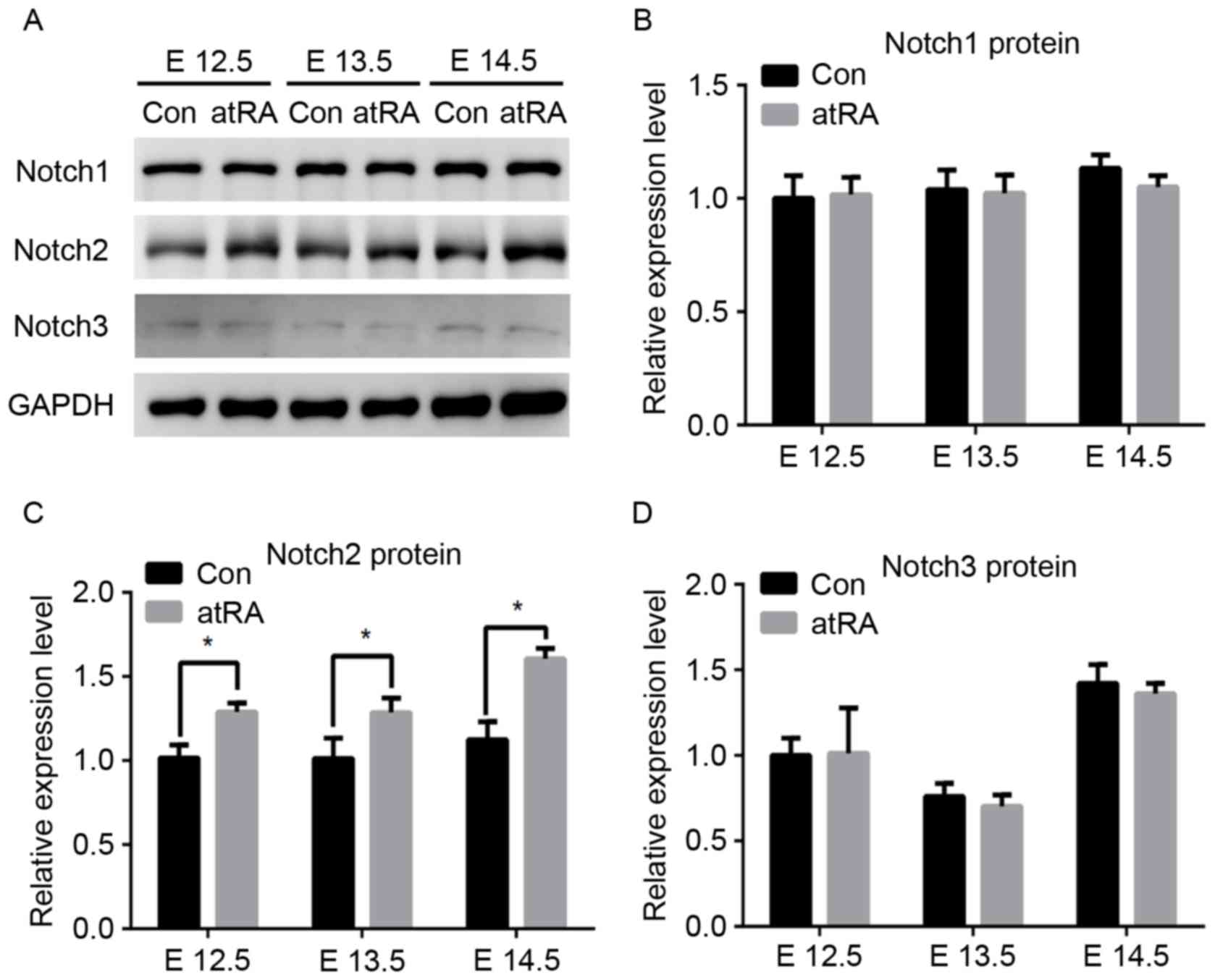|
1
|
Chai Y and Maxson RE Jr: Recent advances
in craniofacial morphogenesis. Dev Dyn. 235:2353–2375. 2006.
View Article : Google Scholar : PubMed/NCBI
|
|
2
|
Wyszynski DF and Beaty TH: Phenotypic
discordance in a family with monozygotic twins and nonsyndromic
cleft lip and palate: Follow-up. Am J Med Genet. 110:182–183. 2002.
View Article : Google Scholar : PubMed/NCBI
|
|
3
|
Hilliard SA, Yu L, Gu S, Zhang Z and Chen
YP: Regional regulation of palatal growth and patterning along the
anterior-posterior axis in mice. J ANAT. 207:655–667. 2005.
View Article : Google Scholar : PubMed/NCBI
|
|
4
|
Ross SA, McCaffery PJ, Drager UC and De
Luca LM: Retinoids in embryonal development. Physiol Rev.
80:1021–1054. 2000.PubMed/NCBI
|
|
5
|
Birnbaum LS, Harris MW, Stocking LM, Clark
AM and Morrissey RE: Retinoic acid and
2,3,7,8-tetrachlorodibenzo-p-dioxin selectively enhance
teratogenesis in C57BL/6N mice. Toxicol Appl Pharmacol. 98:487–500.
1989. View Article : Google Scholar : PubMed/NCBI
|
|
6
|
Abbott BD, Harris MW and Birnbaum LS:
Etiology of retinoic acid-induced cleft palate varies with the
embryonic stage. Teratology. 40:533–553. 1989. View Article : Google Scholar : PubMed/NCBI
|
|
7
|
Cao H, Hu Y, Wang P, Zhou J, Deng Z and
Wen J: Down-regulation of Notch receptor signaling pathway induces
caspase-dependent and caspase-independent apoptosis in lung
squamous cell carcinoma cells. APMIS. 120:441–450. 2012. View Article : Google Scholar : PubMed/NCBI
|
|
8
|
Wang T, Holt CM, Xu C, Ridley C, Jones
POR, Baron M and Trump D: Notch3 activation modulates cell growth
behaviour and cross-talk to Wnt/TCF signalling pathway. Cell
Signal. 19:2458–2467. 2007. View Article : Google Scholar : PubMed/NCBI
|
|
9
|
Baeten JT and Lilly B: Differential
regulation of NOTCH2 and NOTCH3 contribute to their unique
functions in vascular smooth muscle cells. J Biol Chem.
290:16226–16237. 2015. View Article : Google Scholar : PubMed/NCBI
|
|
10
|
Boucher JM, Harrington A, Rostama B,
Lindner V and Liaw L: A receptor-specific function for Notch2 in
mediating vascular smooth muscle cell growth arrest through
cyclin-dependent kinase inhibitor 1B. Circ Res. 113:975–985. 2013.
View Article : Google Scholar : PubMed/NCBI
|
|
11
|
Ying M, Wang S, Sang Y, Sun P, Lal B,
Goodwin CR, Guerrero-Cazares H, Quinones-Hinojosa A, Laterra J and
Xia S: Regulation of glioblastoma stem cells by retinoic acid: Role
for Notch pathway inhibition. Oncogene. 30:3454–3467. 2011.
View Article : Google Scholar : PubMed/NCBI
|
|
12
|
Casey LM, Lan Y, Cho ES, Maltby KM,
Gridley T and Jiang R: Jag2-Notch1 signaling regulates oral
epithelial differentiation and palate development. Dev Dyn.
235:1830–1844. 2006. View Article : Google Scholar : PubMed/NCBI
|
|
13
|
He J, Chen Q, Wang L, Wu F and Du Z:
Corticotropin-releasing hormone receptor 1 coexists with
endothelin-1 and modulates its mRNA expression and release in rat
paraventricular nucleus during hypoxia. Neuroscience.
152:1006–1014. 2008. View Article : Google Scholar : PubMed/NCBI
|
|
14
|
Wang M, Huang H and Chen Y: Smad2/3 is
involved in growth inhibition of mouse embryonic palate mesenchymal
cells induced by all-trans retinoic acid. Birth Defects Res A Clin
Mol Teratol. 85:780–790. 2009. View Article : Google Scholar : PubMed/NCBI
|
|
15
|
Schneider CA, Rasband WS and Eliceiri KW:
NIH Image to ImageJ: 25 years of image analysis. Nat Methods.
9:671–675. 2012. View Article : Google Scholar : PubMed/NCBI
|
|
16
|
Livak KJ and Schmittgen TD: Analysis of
relative gene expression data using real-time quantitative PCR and
the 2(−Delta Delta C(T)) Method. Methods. 25:402–408. 2001.
View Article : Google Scholar : PubMed/NCBI
|
|
17
|
Okano J, Suzuki S and Shiota K:
Involvement of apoptotic cell death and cell cycle perturbation in
retinoic acid-induced cleft palate in mice. Toxicol Appl Pharmacol.
221:42–56. 2007. View Article : Google Scholar : PubMed/NCBI
|
|
18
|
Hu X, Gao J, Liao Y, Tang S and Lu F:
Retinoic acid alters the proliferation and survival of the
epithelium and mesenchyme and suppresses Wnt/β-catenin signaling in
developing cleft palate. Cell Death Dis. 4:e8982013. View Article : Google Scholar : PubMed/NCBI
|
|
19
|
Meloche S and Pouysségur J: The ERK1/2
mitogen-activated protein kinase pathway as a master regulator of
the G1- to S-phase transition. Oncogene. 26:3227–3239. 2007.
View Article : Google Scholar : PubMed/NCBI
|
|
20
|
Kolch W: Coordinating ERK/MAPK signalling
through scaffolds and inhibitors. Nat Rev Mol Cell Biol. 6:827–837.
2005. View
Article : Google Scholar : PubMed/NCBI
|
|
21
|
Weber JD, Raben DM, Phillips PJ and
Baldassare JJ: Sustained activation of
extracellular-signal-regulated kinase 1 (ERK1) is required for the
continued expression of cyclin D1 in G1 phase. Biochem J.
326:61–68. 1997. View Article : Google Scholar : PubMed/NCBI
|
|
22
|
Hwang CY, Lee C and Kwon KS: Extracellular
signal-regulated kinase 2-dependent phosphorylation induces
cytoplasmic localization and degradation of p21Cip1. Mol Cell Biol.
29:3379–3389. 2009. View Article : Google Scholar : PubMed/NCBI
|


















